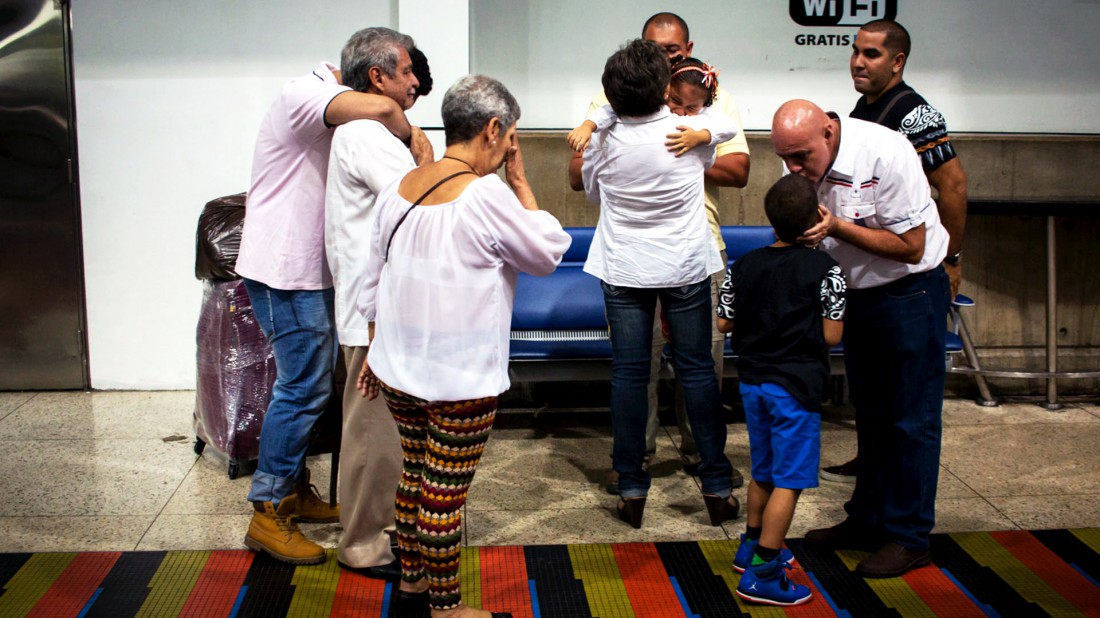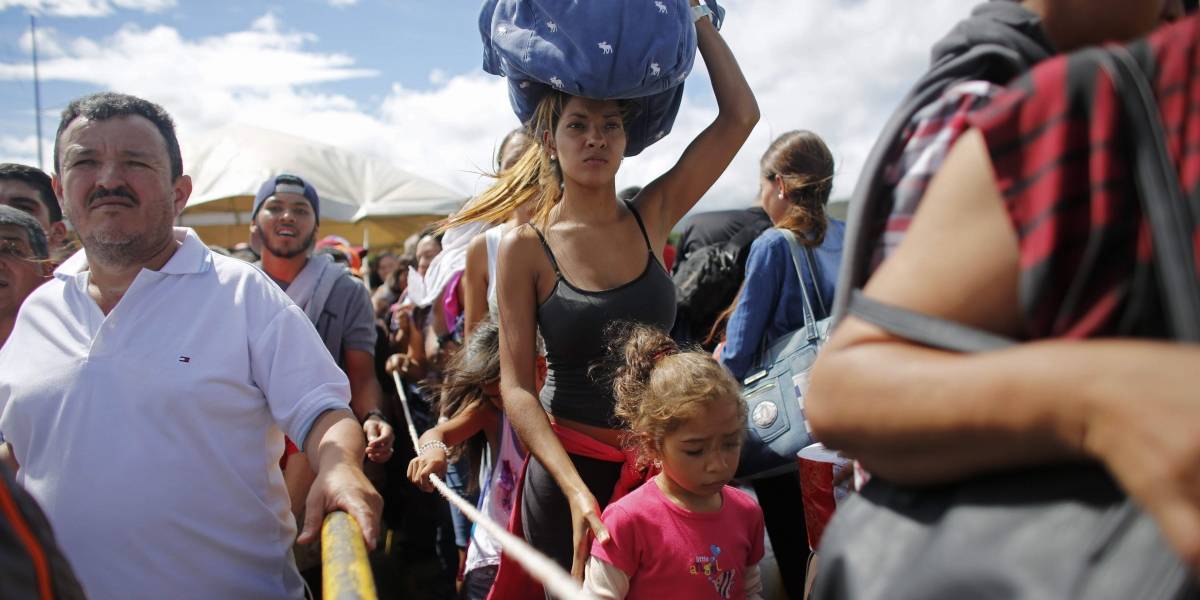Heading Out: A Tale of Three Migration Waves
In 1998, Venezuela had no history of mass migration to speak of. Since then, we’ve witnessed three heaves of outflows: the latest one mass-based. How a peaceful country ended up shedding more migrants than Afghanistan.


Photo: AFP / ModoGráfico
With more than 3 million people displaced, Venezuela is above Afghanistan, Myanmar, Somalia and South Sudan in terms of the highest levels of displacement worldwide. Only Syria is above Venezuela. According to UNHCR data, there are 68.5 million displaced people registered worldwide. With 3.2 million according to the latest official data on Venezuelan displacement, Venezuelans represent 5.1% of the total of displaced people in the world. Although the most recent wave is getting everyone’s attention because it has affected the entire region, there were previous migratory waves of Venezuelans. Three, actually.
First Wave: 2000-2005
 A man walks with his luggage at the Maiquetia international airport. A survey by pollster Datanalisis revealed that 25% of the population surveyed (end of May 2014) has at least one family member or friend who has emigrated from the country. Photo: Leo Ramírez, AFP.
A man walks with his luggage at the Maiquetia international airport. A survey by pollster Datanalisis revealed that 25% of the population surveyed (end of May 2014) has at least one family member or friend who has emigrated from the country. Photo: Leo Ramírez, AFP.
The first wave was in the early 2000s. Venezuela’s economic standing and political uncertainty with the then-recent election of President Chávez were indeed factors of expulsion. This wave was characterized by Venezuelans with favorable economic conditions and high education levels, and with the possibility of processing their residence in other countries as a result of personal patrimony or family ties. It included a small number of industrialists and politicians who felt threatened by Hugo Chávez’s 21st century socialism, and decided to make decisions based on what they’d seen until then.
At the moment, there weren’t imminent risks to their basic rights, but rather threats to their investments and family assets. Also, as a consequence of the paro petrolero in 2002, the Bolivarian government had massive layoffs from the oil production company PDVSA, run by the State. Venezuela’s oil industry decline was multifaceted, but the loss of talent due to migration has been hard to overcome. Venezuela lost more than 20 thousand PDVSA employees, but oil producing countries were smart enough to grab Venezuela’s top talent.
During this first migration wave, Venezuelans’ main destinations included Colombia, given its geographical and cultural proximity, as well as the United States. Countries like Spain, Italy and Portugal, were also receiving countries. Previous immigration from these countries to Venezuela created binational families, with the possibility of accessing European Union passports for these first generation Venezuelans who were ready to migrate.
Second Wave: 2015
 Most Venezuelans don’t know when they’ll see their loved ones again, due to economic difficulties. Photo: Fabiola Ferrero, El Estímulo.
Most Venezuelans don’t know when they’ll see their loved ones again, due to economic difficulties. Photo: Fabiola Ferrero, El Estímulo.
Chavez’s death in 2013 had much to do with this second migration wave, especially because of what came after the transition, how the elections were handled, and the public outrage as a result. This wave included middle class and professionals, with certain economic means to settle in a new country. Economic decline, corruption, monetary madness, repression and clear signs of ineffective public policymaking were the triggers of this second wave.
Another clear reason that made parents send their children out of the country were the 2014 Venezuelan protests, a series of anti-government protests in key Venezuelan cities to question policy decisions that had caused criminal violence, inflation, and chronic shortages of basic goods. By the way, although it’s counterintuitive to migration processes, the climax was Maduro’s decision to close the border with Colombia. Indeed, this first wave also included many Colombians who decided to return to their country as a result of the closing of the border by Maduro in August 2015.
This group of Venezuelan migrants, and Colombian returnees, had similar characteristics to those of the first wave, although it also included middle class professionals and students.
Third Wave: 2017-2018
 Venezuelans now leave the country on foot, running away from a less tha inefficient public health system, hunger, violence and persecution. Photo: AP
Venezuelans now leave the country on foot, running away from a less tha inefficient public health system, hunger, violence and persecution. Photo: AP
The most recent exodus responds to a very particular and complex situation in Venezuela: the persistence of political, social, economic and humanitarian crises. This wave of displaced Venezuelans mainly comprises vulnerable populations, including women travelling alone or with minors, unaccompanied minors, seniors, indigenous populations, a struggling middle class, and the poor. The predominant trend now is for Venezuelans with the least favorable material and health conditions to be travelling to other countries of the region mainly by foot and by bus; the phenomenon of “los Caminantes Venezolanos” is now becoming all the more common.
This migratory wave has been the most intense so far, affecting and challenging the entire region. Some estimate that 2 million have fled this year alone. Materially, this is a population that lost many of its tangible and financial assets in recent years, and lacks the necessary resources to facilitate its settlement in countries of reception. Many of those who leave Venezuela have faced malnourishment and hunger, and some may have infectious diseases previously eradicated in Venezuela (and in the region, for that matter) because of the current conditions of the health system in Venezuela. Others may have chronic diseases improperly attended, or treatable diseases that became chronic because of lack of proper medical attention.
Because of the difficulties in obtaining the right documents to leave the country, such as passports and other forms of identification (Venezuelan IDs or cédulas de identidad, and birth certificates), or to renew them; or because of the lack of more flexible legal frameworks to facilitate their arrival, a large proportion of Venezuelans faces the condition of irregularity in the country of transit or reception. This precarious legal situation re-victimizes them. It contributes to their abuse and exploitation by organized crime or by employers during their transit and in their final places of destination once they settle in a community.
The flows have diversified to new countries, mainly to Colombia, and countries of South America. But this migration wave offers, however, an important opportunity for receiving countries. While Venezuelans have forcibly left the country because of alterations of the public order, and vulnerability in the exercise of their social and economic rights, many of those Venezuelans come with education and professional experience. The key is to take advantage of that talent. If Venezuela isn’t taking advantage of it now, someone has to! Three waves of migrants represent a loss to Venezuela, but a great gain for those who are smart and solidary enough to take them in.
** Points of view are personal. They do not represent the position of the OAS.
Caracas Chronicles is 100% reader-supported.
We’ve been able to hang on for 22 years in one of the craziest media landscapes in the world. We’ve seen different media outlets in Venezuela (and abroad) closing shop, something we’re looking to avoid at all costs. Your collaboration goes a long way in helping us weather the storm.
Donate




